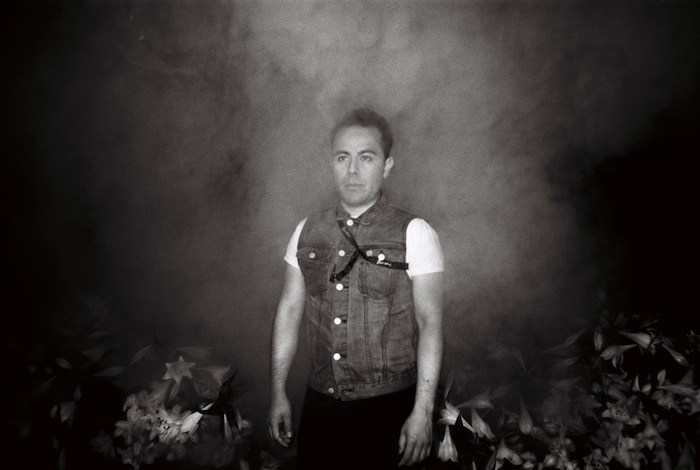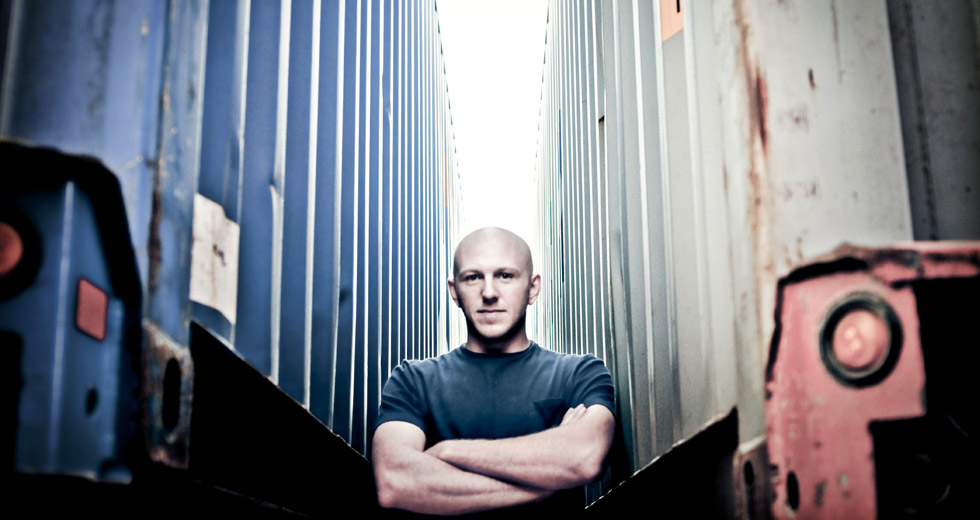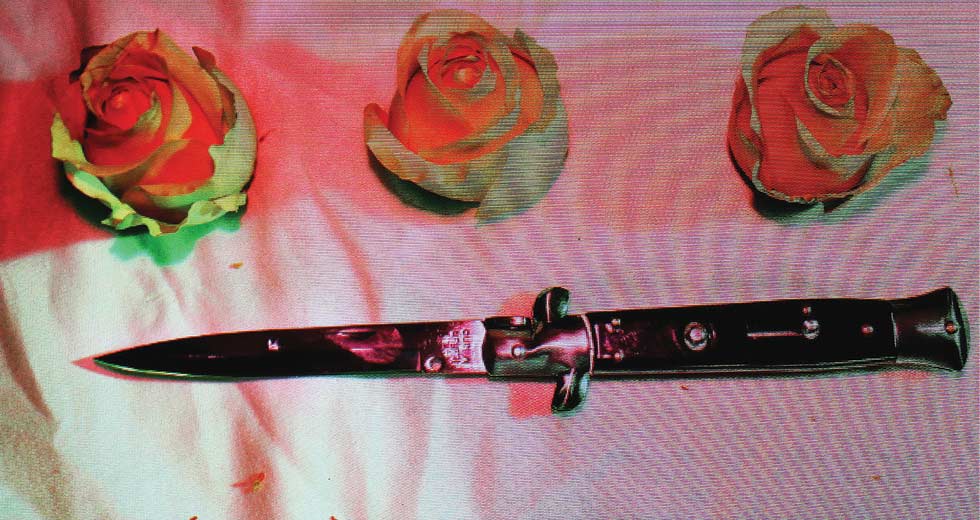Silent Servant on the Influence of the Smiths and the Beauty of Unexpected Connections
Juan Mendez’s Silent Servant moniker first popped up in 2006 as part of label and collective Sandwell District. However, Mendez’s techno origins stretch back to the late ’90s, when he ran avant-techno label Cytrax and its sister label Delay with Steve Tang and Kit Clayton (under his Jasper alias). As a label head and graphic artist, Silent Servant has earned a cult following from techno and industrial heads to goths, punks and cold wave freaks – more recently, he’s been co-running the Historia y Violencia label with Underground Resistance’s Santiago Salazar.
As a producer, Mendez has made collaboration key to his sound, whether working with his ex-wife Camella Lobo’s band Tropic Of Cancer or with Downwards boss Regis as the duo Sandra Electronics. The combination of anonymity, DIY attitude and political edge in his taut and propulsive music has come to shape the darker atmosphere in much contemporary techno. In these condensed excerpts from his RBMA Radio Fireside Chat with Hanna Bächer, Mendez discussed some of his unexpected influences and experiences of discovery that led to his current sound.

The Influence of the Smiths
My brother used to hang out with these two death-rocker skater kids. One was named Zack and the other one was Derek. They both had the long bangs. I still have it – one of them did this pencil sketch of the Smiths. It was from his notebook and I’ve kept it for over half of my life, basically. At that time it was the tail end of new wave, the late ’80s. It was also in California, so we had KROQ. What KROQ is now is completely different, but at the time it was like the radio station.
There was also weird new wave clubs that my brother would go to. We would mail-order records from Columbia House, which is this mail-order that you would get out of TV Guide. It was five cents for ten records or something like that... Some of those records I still have. We got the Smiths’ Louder Than Bombs, The Queen Is Dead, Echo & the Bunnymen’s Ocean Rain, the Cure Standing on a Beach singles. Then a couple of really random things like Simply Red and stuff like that that I don’t listen to anymore.
A lot of that Smiths stuff is still very much why I do things the way that I do them. It was this fascination with the iconography and this weird pop star idealization.
There would be James Dean on the cover, Elvis Presley, all these British soap opera actors, Viv Nicholson. Things that I didn’t know about – they’re very foreign to me. As a kid you see these things and you’re like, “Wow, this is really cool, and I know nothing about this. It’s so foreign, I live in California.” It’s the idealization of what British culture is.
I remember being in high school, and we didn’t have social media. The way you connected with people you would see, you would look at them and be like, “OK, how is this person dressed?” Are they wearing a band t-shirt? Are they wearing Creepers? Are they wearing Dr. Martens or something?
If you saw someone wearing Creepers and a band t-shirt you would be like, “Oh, I would maybe get along with that person,” and you would just go talk to them. A lot of it was that kind of stuff. It’s this fascination with all of these nostalgic things, but at the time they were kind of real-time. It’s still the stuff that I really love. If you look, I still dress the same way that I did then, which is kind of weird.
Again, my brother was really instrumental. He was going out to these clubs and I wasn’t old enough. We would go with my mother, drive him to the clubs and drop him off, and pick him up at one in the morning or midnight. I got to meet all these really great people through him at a young age.
As an adult you look at the nostalgia as really funny. For example, Morrissey published a couple of books, and one was of B movie stars that died. It’s people like Sal Mineo – Sal Mineo was in Rebel Without a Cause, but was the younger kid that didn’t get as big as James Dean. The girls that weren’t Marilyn Monroe, but they were like, “This is the next Marilyn Monroe.” What all that embodies.
Sometimes we’ll go to venues in LA, or just restaurants or something that have been there since that era, and they’re really beautiful. You’re like, “Wow, this has been there since that era.” Weirdly enough, I think in Europe there’s some parts like that, but Hollywood was this thing. Glenn O’Brien said it in this article that he wrote about LA. It’s like, “Hollywood: the brighter the light, the darker the shadow.”
Embracing Electronic Music
My whole introduction to electronic music was in steps, and it had a lot to do with MTV at the time. Basically, we had 120 Minutes, which was like the late night alternative video show. It was two hours, Sunday nights from midnight to two. That’s the first place I heard My Bloody Valentine – anything from that to Lush, Slowdive, Curve, Stone Roses, Charlatans. All the UK stuff, basically, was very prevalent.
Also, a lot of stuff like Sonic Youth. Sonic Youth is another band I grew up listening to a lot of. At the very end, a few times I remember the Aphex Twin video came on – it was the video for “On.” I just remember it’s almost two in the morning and I’m in high school, and I’m like, “You should not be up," because I have to go to school the next day. I remember seeing this video and being like, “Whoa, what is this?”
Then we would go to these clubs, and then also there was after-parties, and we would go to the after-parties. Slowly, just from being at a dance club you’re like, “Oh, this stuff is pretty cool.” Then I met this guy Marcus Miller – he became one of my really good friends. He actually taught me how to DJ. This guy was really instrumental in showing me dance music properly. He played me this compilation – he actually gave it to me – In Order To Dance; I think number five. It was like an R&S compilation that had Basic Channel, Kenny Larkin, Carl Craig, Frank De Wulf and all this stuff like that on it. I’m like, “Wow, I want to find more of this.”
There were events happening in LA. There was a guy Joe Babylon and this other guy Allen Avanessian – they ran this label called Plug Research, which still runs but it’s changed. At the time they were actually helping Carl Craig hand out records, Planet E records, just so people would know about it, promo-style. They gave me a copy of the Connection Machine and The 4th Wave and a Gemini record. I was like, “Oh, this is really awesome,” and I asked this guy Joe, “Hey, where can I get more of this?” He’s like, “Here, take this number, do you have a fax machine at home?” I’m like, “Yeah, my parents have one.” He’s like, “OK, take this number, just fax them that you want the catalog and they’ll send it to you.” It was the number to Submerge.
From there I started ordering. It was at the time when the first Chain Reaction records are coming out, and I was buying all the Maurizio records, buying all the Basic Channel records, buying Drexciya records. Everything: Metroplex, UR, Transmat, any of that. Also, the weird German stuff they do, which was like Chain Reaction, Basic Channel, Maurizio. That stuff became what I really fell in love with.
How does someone go from Palais Schaumburg to Maurizio? The beauty of that is what made me realize it’s this progression of being able to make weird music, and progress of ideas.
Adrian Sherwood and the Beauty of Unexpected Connections
I love the beauty of someone like Adrian Sherwood. When you look at Adrian Sherwood as a producer, he would touch a Ministry record, but he would touch African Head Charge. By no means am I comparing myself to that. All I’m saying is, for me, when I listen to certain Basic Channel things, it’s like this metallic, industrial dub stuff. It’s the same idea. It’s these infinite loops and they’re really harsh. When I think of Basic Channel, there are so many paradigms there. Yes, there’s the dub processing, but it’s also very futurist.
Also, when I think of someone like Moritz von Oswald, he was in Palais Schaumburg. When I found that out I was like, “What is this?” Then you look at the whole dichotomy of what was happening in Germany... Pyrolator, just so many bands. All that stuff, all that German, Deutsche Welle stuff, for me, when I found out about that, it all made sense in a way, and then seeing the progress of that, for me, is why it worked. I started understanding the steps of dance culture. It’s the same approach. How does someone go from Palais Schaumburg to Maurizio? The beauty of that is what made me realize it’s this progression of being able to make weird music, and progress of ideas.
My introduction to Deutsche Welle was I went to this club in New York right around this time, post all the Cytrax stuff and all that. My friend Marcus had moved to New York and he took me to this club – I don’t even know who was DJing. I know there were a couple of girls and they were playing A Certain Ratio, Tuxedomoon, what are considered now these weird post-punk industrial new wave “hits,” when people are like, “Oh, I can’t even hear that anymore,” I’m like, “But it’s still good!” It’s what people do – it’s hilarious.
[Marcus] gave me this list of records to look for, like ESG, James White and the Blacks or the Contortions, Delta 5, Bush Tetras. There was some Jah Wobble stuff on there, some Adrian Sherwood stuff that he’d produced. It was this list, and he was like, “Go look for these records,” and I was like, “OK.” I was at this club and I’d told him, “Dude, I don’t know any of this. It sounds like stuff that I should know but I don’t know anything.” He’s like, “Yeah.” It was before the reissue thing started happening, too.
That became my introduction to that, and also at the time there was a DJ Hell and Disko B – I forget who the other guy was, but they did this compilation called New Deutsch and it had all this German new wave stuff. That was for me again, that compilation was bands like Stratis, Pyrolator, “Suicide Commando.” All this stuff that I had never heard. That became what I was really attracted to. I’m always drawn to emotive things. Things that have a sense of – I don’t want to say emotion – but I do like when things have drama.
That’s why I always use strings in my music. I like things that sound like that. New wave always had that, and a lot of this stuff had harmonics like that. It’s what I love about it... The connection for me was to see the progress of how producers could go. Let’s say PIL – it’s dub basslines, but it’s post-punk, but there’s a lot of things there that make it special. There’s actually a couple of compilations – I think they’ve been out for a year or two – called Sherwood At The Controls, and it compiles all of the records that he mixed or remixed and things like that. You look at those, and it’s like he could do something like Medium Medium for 99 Records but also do a remix for Ministry. That’s awesome for me.

